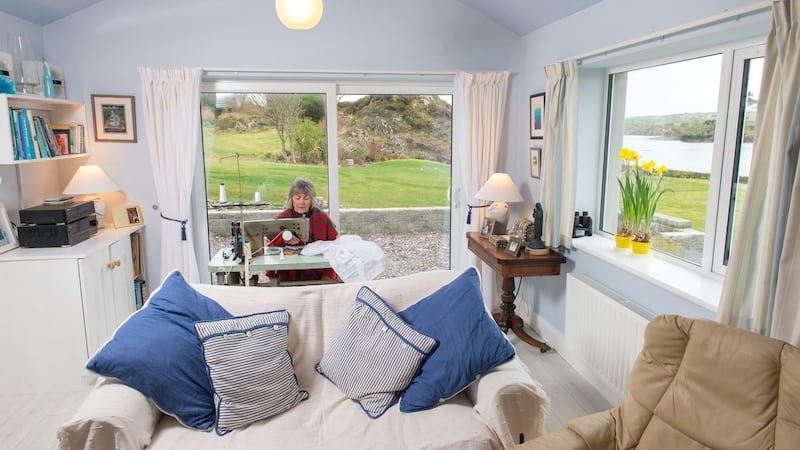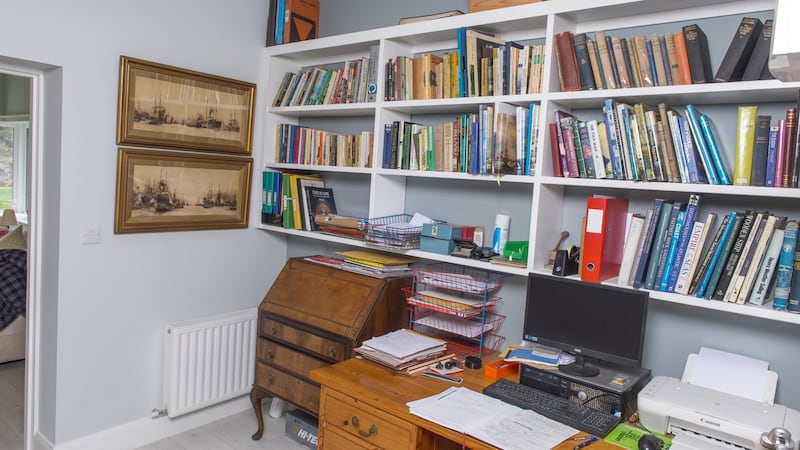Bebhinn Marten looks around her kitchen with satisfaction. “Robert and I had agreed on the work we each would do and he wanted to build the kitchen. But I knew in that case it would be built like a boat so basically we designed it together.”
It is nothing like a boat. Given the seaside location of this house and the fact that Robert is a boat-builder, some nautical influence might be expected but there is no overtly maritime clutter. There is no clutter at all, for the Martens have downsized to a bigger house. Not many people choose to do that, but then not many people have an empty knitwear factory on their hands and right beside the one-bedroom apartment in which they have been living during a time of change.
Their shared preoccupation with those who go down to the sea in ships was expressed in their very early production of boatswain sweaters from which their company, Beacon Designs, developed through the late 1970s and which, thanks to their awareness of the IMI advice to "always have a new cow to milk" exported their distinctive fashion knitwear around the world until 2017. Together the Martens provide a personal and well-documented account of the steep decline in the Irish woollen industry, personified for them in the lack of training courses and apprentices and even here, in this friendly kitchen, typified by the ceiling's pitch-pine beams which came from Dripsey Woollen Mills. The reasons for the decline since about 2007 are various but culminated in their decision to retire.
It's been a mixture of heartbreak and relief, but in the end we wound up with a clean sheet and a new house
“Well, Robert decided and I followed suit, kicking and screaming. We still had customers, but we couldn’t sell the business as a going concern. It’s been a mixture of heartbreak and relief, but in the end we wound up with a clean sheet and a new house.”
Sparkling, smart and full of light falling in from the waters around Ringaroga island, the house will not be viewed by many visitors as it is seen by Bebhinn and Robert, to whom each room is still somewhere else. On a window-ledge by the stairs is a tall jar full of coloured buttons. They are from the sturdy jerseys of the 1970s, dyed to match Bebhinn's yarn by the Cork Button Company. The shower cubicle in the downstairs bathroom was the porch over the factory door. The upstairs bedroom with its en suite bathroom was the design room; this has a casement window instead of a Velox: "it was much quicker to put it in, no need to open the roof space, and you can't see easily out of a Velox".

Looking out, the view is over the inlet where the river Illen meets the sea. This is the only new window in the house; all the others were lowered to avoid having to raise the existing lintels, and all the nine doors were salvaged from the factory and given new door-frames. The stair carpet is held with chrome rods; “those were hard to find so we got them through the internet, but apart from that and the curtaining I don’t think we bought anything outside of West Cork – you’d be amazed what’s available here and if they don’t have it they’ll get it for you.”
This long kitchen, with windows facing south and west, was the shop: “We were determined in the renovation to keep it big, but even at that it was an extension of the original building from 1983 which had eleven corners so it could be adapted from any direction. That was the plan, it had to be versatile.”
Versatility in fact became something of a slogan for the Martens who, with their four children moving on, had changed from their first home in Baltimore to a new house adjacent to the factory. On the same site they built the apartment and it was to this that they moved when they decided to cease production and sell the house. Bebhinn doesn't use the term down-sizing; basically it was a matter of moving out of one property and into another with some difference in available space. That makes it seem easy, but having made their final decision to convert the factory itself into their permanent residence and with Robert's meticulous plans complete, they discovered some unexpected problems in the shape of the intricacies of planning law regarding change of use.

"It took two years to get through. The architect Peter Murphy produced the application and the drawings for the conversion to residential. However it was treated as a new build and there were also a lot of new regulations to observe. I really think that this is why so many Irish towns now have these abandoned buildings, old closed-down shops which nobody can live in because of the 'change of use' rules."
In the worrying meantime they sold the house, the plant and stock and Bebhinn filled 30 archive boxes with her designs, patterns, photographs and development plans. With all financial obligations met and with their younger son Olan, who computerised the factory's knitting machines, moving on to McKernan Weavers in Co Clare, once things began to move, they moved very quickly. The Martens were their own supervisors in co-operation with local builder Michael Leonard and "a great team of people" with the result that the reconfiguration from factory to home was completed in five months.
We went to a lot of trouble with some things – like handles: door-knobs are terrible when you're getting elderly
“We never changed our minds. We stuck to our plans, there were endless questions but we never changed so there were no delays. We went to a lot of trouble with some things – like handles: door-knobs are terrible when you’re getting elderly. And incidentally, if you get these fittings with locks and keys they’ll cost €40 an item, without them only €20 – and nobody needs a lock and key for every door in the house!’
Bebhinn made all the curtains: "I love Laura Ashley and their service is superb, I got it all using their catalogue and the telephone." A sewing machine from 1969 still stands all threaded up in a sunny sittingroom; the fish-patterned decorations on the doors came in a wedding present of 40 bevelled glass finger-plates from her father, the sculptor Seamus Murphy, but she put the little fish in herself. The furniture is a combination of old pieces from Robert's family and items bought over the years, and includes a desk made by the sculptor Joseph Higgins, father of Bebhinn's mother Maighread Murphy.
The Martens now live in a three-bedroom house of 1,800sq ft surrounded by its wide garden of lawn and rock close to the village of Baltimore. It reveals the talents and skills of both of them at their creative best, sustained from the days when, as Bebhinn says, "there wasn't a yacht on the Cowes to Fastnet race that didn't have a Beacon jumper on board".
Later, as we drive to catch the bus in Drimoleague, a figure walks carefully in the direction of the oncoming traffic, tipping his hat low against the rain. Even in the rain he looks familiar.
“Is that Jeremy Irons?”
“Probably; that’s the Puttnam place we’re passing . . .”
It’s that kind of place, West Cork. It’s amazing what you’ll find there.











